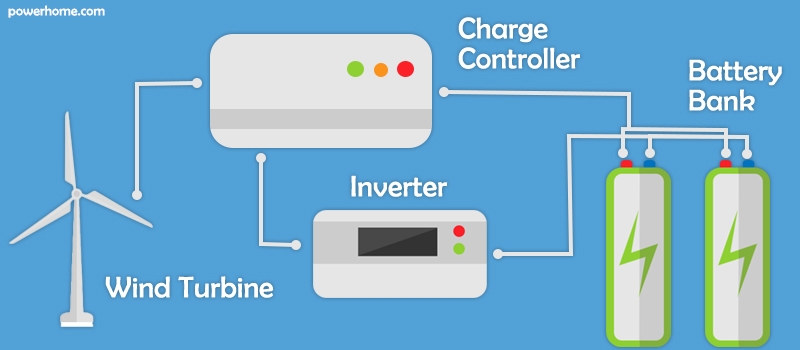With the development of renewable energy technology, wind power generation, as an important green energy, is gradually being widely used in various fields. As a key component in the wind power generation system, the correct use of the wind power controller is crucial to ensure the stable operation of the system and improve the efficiency of energy utilization. This blog will introduce the use of wind power controller in practice, to help you better understand and apply this technology.
Wind Turbine Controller Overview
Wind power controller is the core equipment in the wind power generation system, which is mainly responsible for regulating the output power of the generator to ensure that the system can operate stably under various wind speed conditions. The controller realizes the intelligent control of the system by monitoring the output voltage and current of the generator and the charging status of the battery.
According to different functions and application scenarios, wind turbine controllers can be categorized into MPPT controllers, PWM controllers, dumping controllers, integrated controllers, etc. MPPT controllers are suitable for areas where wind speed varies greatly, such as mountainous areas or coastal areas, while PWM controllers are suitable for wind turbine power generation systems that need to regulate output power frequently. Integrated controllers combine the advantages of both, and are suitable for wind power systems that need to consider maximum power point tracking, battery charging control and load protection. For example, this 2kW wind turbine controller has a maximum power point tracking function and can also realize stepless PWM dump load.
How to Use
Installation and Connection
First, make sure that the wind turbine charge controller is properly connected to the turbine generator, battery and load. Check that all connections are secure and make sure there are no loose or damaged wires. Follow the manufacturer's instructions for initial setup, including setting the battery type, charging voltage, and current limit. Always ensure that the controller is switched off when connected.

There are various types of wind turbine controllers, some are used in off-grid systems, some in grid-connected systems, and some are used in both cases. In the case of a grid-connected wind turbine system, the power generated by the generator can only be consumed by the dump load resistor in the event of a grid outage. At the same time, the control system will not be able to control the rotor deflection due to loss of power. Therefore, it is recommended that grid-connected users connect a UPS device.
Startup and Monitoring
Turn on the wind turbine controller and start generating power. Regularly check the status of the system, including the output of the generator, the state of charge of the batteries and the consumption of the load. Ensure that the system is running normally. If there are any abnormalities, stop power generation immediately and find out the cause.
A general wind power controller can display the wind direction and wind speed of the turbine; the generator's speed, temperature, output voltage, current, power and other information. When the generator over speed, over temperature and other abnormal conditions, the controller will issue an alarm. Advanced wind controllers with digital displays and touchscreens are preferred for more intuitive monitoring of values.
Adjusting Settings
Adjust the controller settings to optimize system performance according to actual use and environmental conditions. Parameters such as maximum output power, alarm wind speed, dumping threshold, charging mode, may need to be adjusted. When adjusting settings, read the controller manual carefully and follow the manufacturer's instructions. Some controllers support remote control, and it may be necessary to download a special mobile app or computer software so that the settings can be adjusted more easily.
Tips for Use
Follow the Manufacturer's Guidelines
The design and manufacture of wind power controllers requires consideration of a variety of factors, including the type of generator, the size of the system, and the user's requirements for system performance and automation level. In practice, the manufacturer's instructions should be strictly followed to ensure stable system operation.

Regular Inspection and Maintenance
Wind turbine controllers and their connected equipment need to be regularly inspected and maintained to ensure long-term stable operation of the system. The inspection includes the surface of the controller, circuit connections, battery status, and so on. During the inspection process, attention should be paid to safe operation to avoid the risk of electric shock.
If the system malfunctions or becomes abnormal, refer to the controller manual for troubleshooting. It may be necessary to check circuit connections, adjust settings, or replace damaged components. During troubleshooting, safe operation should be observed to avoid the risk of electric shock.
Attention to Environmental Factors
The wind power system is greatly affected by environmental factors, such as wind speed and temperature. In actual operation, attention should be paid to the impact of environmental factors on the system, and adjust the controller settings according to the actual situation. For example, when the wind speed varies greatly, the charging voltage and current limit should be adjusted appropriately to prevent the battery from being overcharged or over-discharged.
Improve Safety Awareness
Wind power generation systems involve high-voltage electrical energy, so in actual operation, safety awareness should be raised to avoid the risk of electric shock. Turn off the controller and disconnect all connections when the wind power system is not required. Ensure that all equipment is in a safe condition to avoid the risk of electric shock. During shutdown and shutdown, attention should be paid to the working status of the controller to avoid misuse.
The correct use of wind turbine controllers in practice is of great significance in ensuring the stable operation of the system and improving the efficiency of energy utilization. If you have any questions about installation or use after purchasing a product, you can visit powerhome.com and contact us for assistance. By following the manufacturer's instructions, regular inspection and maintenance, you can ensure the long-term stable operation of the wind power generation system and give full play to its economic benefits and environmental advantages.
(1).png)
(1).png)